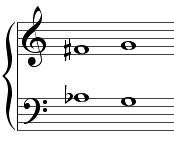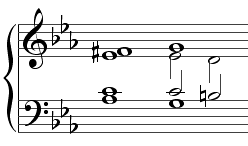
This progression as the same function as the Dominant 7th, since the sound sounds like a Dominant 7th, but this progression is special! It works as Pre-Dominant since you need to actually resolve to the actual Dominant, like Secondary Dominants! Lets imagine this case! 6b - 1 - 4# (Ab - C - F#). Ab to F# sounds like a minor 7th, doesn't it? In terms of sounds it is correct... but in terms of theory it isn't. In this case it is an Augmented 6th Interval!
There are 3 types of Augmented 6th chords! Althought there is another one which is not really an augmented 6th but its progression is very uncommon being the Neapolitan 6th chord! I'm using "C Major Scale" for explanation purposes!
Sorry for my english!
----------------------------------------------------------------------------------------------------------
Italian Augmented 6th (It6) - This one is the most common one. It has a very noticeable cadence to the Dominant!(6b - 1 - #4), 6b is the minor 6th and #4 is the augmented 4th, since the interval distance is an augmented 4th (C;F#). It resolves to the dominant, so 6b decends to 5 and 4# ascends to 5. So that, 5 is G. So you finish the resolution to G-major. Why are we omiting the 5th from the italian augmented chord? The 5th in this case b3 (Eb) would resolve to 2 (D), but like this is classical Theory, this can't happen. We would be inputing the most common enemy and error of the composer in the classical Era. Parallel 5th's happen to be between Ab and Eb; G and D.

French Augmented 6th (Fr6) - This one is common more in the Impressionism Era, it is more associated in the 19th century. It is the same thing as the Italian but it has an additional tone, the 2nd (D). So it forms like this (6b - 1 - 2 - #4). The D doesn't need to move because you can't suffer with parellel 5th's mistake! It is referenced to be using the Whole Tone or Hexatonic Scale!

German Augmented 6th (Gr6) - This one is very complex and not easy to explain, because it's form and resolution is diferent than the others! The German sixth is almost equivalent to the Italian Sixth but has an additional tone b3 (Eb). Do you remember what I said about the Italian 6th that they omited the 5th because of contrapunctual and voice-leading issues? Here is that chord where things happen! (Magic Shmagic *snort*). So the Form is 6b - 1 - b3- #4. Unlikely the other 2, this one has 2 options to resolute this chord...
1 - Omit the 5th! There is a reason why this chord is hardly used by many classical composers. It is because of its voice-leading problems! Beethoven has used it a lot. the b3 can not go to 2 or 1, so that being an issue! If you omit the 5th, you have an happy Italian 6th Chord!
2 - Use contrary motion (oblique motion) to avoid the awful parallel 5th's! This is heavenly remedy for this solution! Thank god for the experts like Bach, have been such experts on contrapunct. You can resolve this cadence to a I 6/4 or i 6/4 to intensify the the Dominant even more. After this progression, you can finally resolve to the dominant. Many people respell the b3 to a #2, for a similiar voice leading as b3.

i 6/4 progression to resolute to the Dominant!

Parallel 5th's!
Thank you for reading this tutorial! I hope I could help some people out!
Cheers,
Docinterlude
